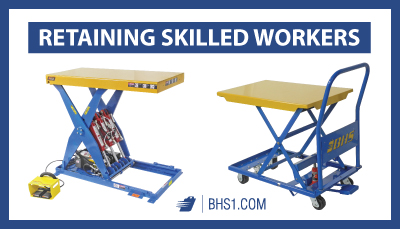We use cookies to make your experience better. To comply with the new e-Privacy directive, we need to ask for your consent to set the cookies. Learn more.
Retaining Skilled Workers
America's supply of skilled workers isn't as young as it used to be, and the trend has no end in sight. The Bureau of Labor Statistics predicts that, by 2024, 41 million workers will be 55 or older. For the manufacturing sector and other industries with higher physical demands, this trend could mean more sick days and reduced productivity.
While older Americans are healthier than ever, they are still more likely to need time off for episodic or chronic health problems than their younger counterparts. Thankfully, there are a number of ergonomic solutions that can help older workers stay healthy and productive, and one international company has shown a proven way to implement them.
One German automotive manufacturer has been an early adopter of strategies for retaining older skilled workers.
In 2007, management at BMW's powertrain plant in Dingolfing, Germany, decided to tackle the problem of an aging workforce before it occurred. They knew that the average worker age would rise from 39 to 47 by 2017, so they decided to accelerate the situation. Managers transferred older workers to a single line so that the average age on it was 47.
What happened next offers a blueprint for companies in countries with aging workforces. Management worked with technical experts and workers to develop changes in habits and equipment. The goal was to keep the older population, which was more susceptible to injury and illness, from lagging behind or requiring excessive time off.
Through consultations with workers, managers learned about commonly encountered problems.
For instance, many workers complained about sore feet and knees.

Job rotation ensured that workers didn't prematurely tire physically or mentally. Initially, workers were against this change, but soon they realized the benefits — for them and for the product. A physiotherapist guided the workers in stretches and strengthening exercises to keep staff healthy.
The results were overwhelmingly positive for the factory and its older workers.
The result of all these changes was a 7 percent increase in productivity. Absenteeism due to sick leave and other health reasons dropped from the typical rate of older workers to below the average for the entire plant. BMW credits these successes to the collaboration of upper management initiating the project, production managers running the experiment, and workers buying in and participating.
"It's so simple, but it seems to work," production manager Helmut Mauermann told CBS News. The total cost of the changes was approximately $50,000, which was made up for through a drop in defect rates, reduced absenteeism, higher productivity, and gaining crucial knowledge that management can apply to other factories.
Manufacturing companies in the United States faces many of the same issues as BMW.
A labor force shortage is spurring U.S. factories to hang on to older workers in creative ways. Factories in Minnesota have been offering more flexible schedules in addition to upgrading equipment to better suit older staff. CVS offers a "snowbird" program that transfers hundreds of older pharmacists from northern states to the south for winter months.
All of the above solutions came from collaborative approaches between management and employees. By understanding and addressing the needs of older workers, companies were able to retain them. The positive results show that skilled workers in an aging workforce can provide plenty of productivity when given the right circumstances.
References:
DePass, Dee. "More Minnesota factories convincing employees to work past 65." StarTribune. Star Tribune, 8 July 2017. Web. 14 Feb. 2018.
Greenhouse, Steven. "The Age Premium: Retaining Older Workers." NYTimes. The New York Times Company, 14 May 2014. Web. 14 Feb. 2018.
Lester, Gillian. "The Aging Workforce and Paid Time Off." IRLE. Institute for Research on Labor and Employment, University of California, Berkeley, 2009. PDF. 14 Feb. 2018.
Lock, Christoph, Fabian Sting, Nikolaus Bauer, and Helmut Mauermann. "The Globe: How BMW Is Defusing the Demographic Time Bomb." BHR. Harvard Business Review, Mar. 2010. Web. 14 Feb. 2018.
Roth, Richard. "How BMW Deals With an Aging Workforce." CBSNews. CBS Interactive Inc., 5 Sept. 2010. Web. 14 Feb. 2018.
Toossi, Mitra and Elka Torpey. "Older workers: Labor force trends and career options." BLS. Bureau of Labor Statistics, U.S. Department of Labor, May 2017. Web. 14 Feb. 2018.
Categories: Education, Ergonomics, Manufacturing, Warehouse Equipment
Tags: skilled workers, labor shortage, lift tables, ergonomics
